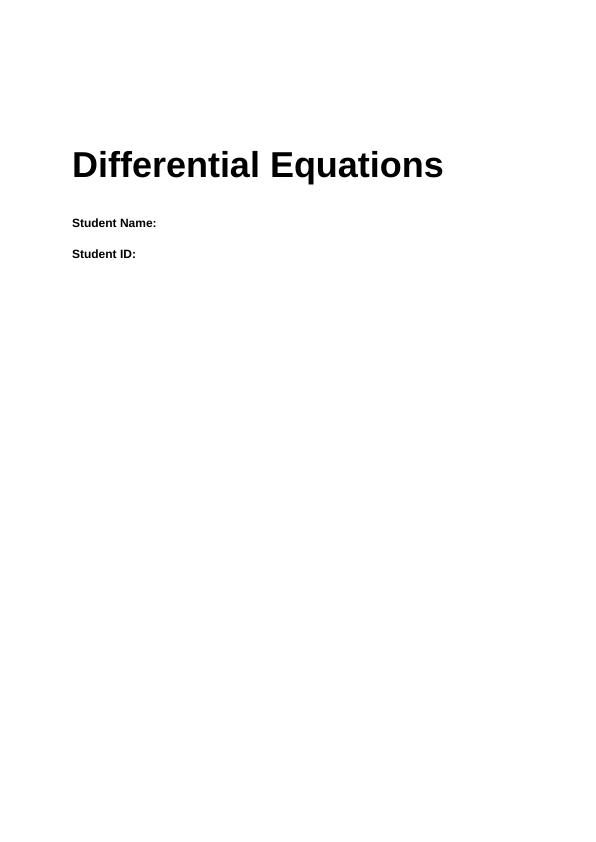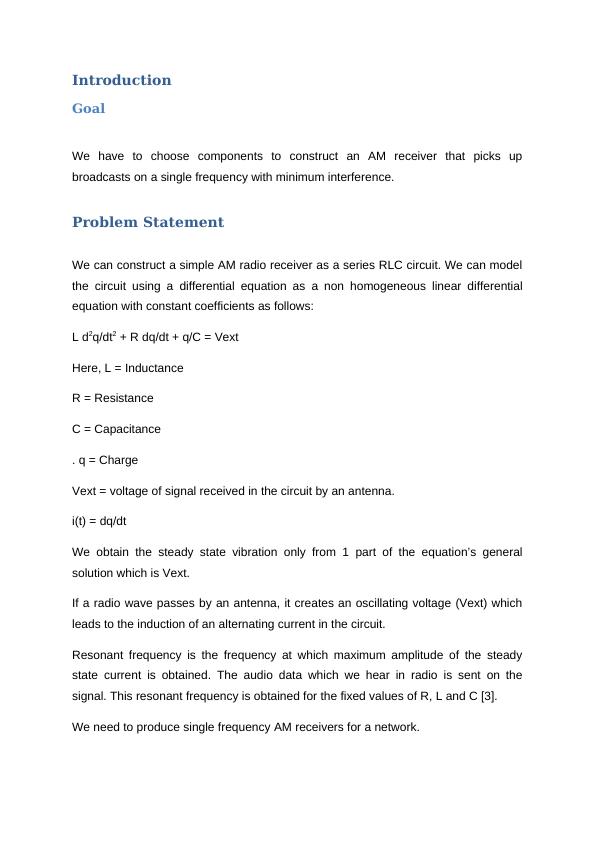Designing an AM Receiver using Differential Equations
Added on 2022-11-27
12 Pages2610 Words101 Views
Differential Equations
Student Name:
Student ID:
Student Name:
Student ID:

Contents
Introduction........................................................................................................... 3
Goal.................................................................................................................... 3
Problem Statement................................................................................................ 3
Components used ( with reason )..........................................................................5
Evaluation of possible design options....................................................................5
Similar Result design options.................................................................................7
Comparison of options........................................................................................... 8
Future designs..................................................................................................... 11
Conclusion........................................................................................................... 11
References........................................................................................................... 12
Introduction........................................................................................................... 3
Goal.................................................................................................................... 3
Problem Statement................................................................................................ 3
Components used ( with reason )..........................................................................5
Evaluation of possible design options....................................................................5
Similar Result design options.................................................................................7
Comparison of options........................................................................................... 8
Future designs..................................................................................................... 11
Conclusion........................................................................................................... 11
References........................................................................................................... 12

Introduction
Goal
We have to choose components to construct an AM receiver that picks up
broadcasts on a single frequency with minimum interference.
Problem Statement
We can construct a simple AM radio receiver as a series RLC circuit. We can model
the circuit using a differential equation as a non homogeneous linear differential
equation with constant coefficients as follows:
L d2q/dt2 + R dq/dt + q/C = Vext
Here, L = Inductance
R = Resistance
C = Capacitance
. q = Charge
Vext = voltage of signal received in the circuit by an antenna.
i(t) = dq/dt
We obtain the steady state vibration only from 1 part of the equation’s general
solution which is Vext.
If a radio wave passes by an antenna, it creates an oscillating voltage (Vext) which
leads to the induction of an alternating current in the circuit.
Resonant frequency is the frequency at which maximum amplitude of the steady
state current is obtained. The audio data which we hear in radio is sent on the
signal. This resonant frequency is obtained for the fixed values of R, L and C [3].
We need to produce single frequency AM receivers for a network.
Goal
We have to choose components to construct an AM receiver that picks up
broadcasts on a single frequency with minimum interference.
Problem Statement
We can construct a simple AM radio receiver as a series RLC circuit. We can model
the circuit using a differential equation as a non homogeneous linear differential
equation with constant coefficients as follows:
L d2q/dt2 + R dq/dt + q/C = Vext
Here, L = Inductance
R = Resistance
C = Capacitance
. q = Charge
Vext = voltage of signal received in the circuit by an antenna.
i(t) = dq/dt
We obtain the steady state vibration only from 1 part of the equation’s general
solution which is Vext.
If a radio wave passes by an antenna, it creates an oscillating voltage (Vext) which
leads to the induction of an alternating current in the circuit.
Resonant frequency is the frequency at which maximum amplitude of the steady
state current is obtained. The audio data which we hear in radio is sent on the
signal. This resonant frequency is obtained for the fixed values of R, L and C [3].
We need to produce single frequency AM receivers for a network.

The purpose is to maximize the signal amplitude received from the base stations
which are broadcasting at a frequency of 1200 kHz.
We must change this frequency to the unit of rad/s. 1200 kHz = 2π x 1200 x 1000
rad / s
.ω = 7539.8 x 1000 rad/s
Let us assume Vext = sin ωt
L d2i/dt2 + R di/dt + i/C = sin ωt
d2I/dt2 + R/L di/dt + 1/LC i = (1/L) sin ωt
This is the required differential equation.
By solving this equation, find the relationship between Current (I) and time (t).
Solution:
Complimentary function:
D2 + R/L D + 1/LC = 0
D = α , β
I = A eαt + B eβt
Particular Integral :
I = 1 / D2 + R/L D + 1/LC ((1/L) sin ωt )
Put D2 = - ω2
Another need is to minimise the signal amplitude received from other commercial
radio stations broadcasting across the region. Their signals are in the frequency
range of 600 – 1150 kHz and 1220 – 1600 kHz.
. fl1 = 600 + 1150 / 2 = 875 kHz
fl2 = 1220 + 1600 / 2 = 1410 kHz
which are broadcasting at a frequency of 1200 kHz.
We must change this frequency to the unit of rad/s. 1200 kHz = 2π x 1200 x 1000
rad / s
.ω = 7539.8 x 1000 rad/s
Let us assume Vext = sin ωt
L d2i/dt2 + R di/dt + i/C = sin ωt
d2I/dt2 + R/L di/dt + 1/LC i = (1/L) sin ωt
This is the required differential equation.
By solving this equation, find the relationship between Current (I) and time (t).
Solution:
Complimentary function:
D2 + R/L D + 1/LC = 0
D = α , β
I = A eαt + B eβt
Particular Integral :
I = 1 / D2 + R/L D + 1/LC ((1/L) sin ωt )
Put D2 = - ω2
Another need is to minimise the signal amplitude received from other commercial
radio stations broadcasting across the region. Their signals are in the frequency
range of 600 – 1150 kHz and 1220 – 1600 kHz.
. fl1 = 600 + 1150 / 2 = 875 kHz
fl2 = 1220 + 1600 / 2 = 1410 kHz

End of preview
Want to access all the pages? Upload your documents or become a member.
